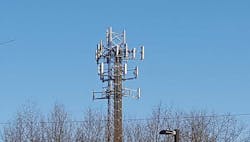Roundtable: 5G Will Boost Business for Data Centers, But Not Overnight
Today we continue our Data Center Executive Roundtable, a quarterly feature showcasing the insights of thought leaders on the state of the data center industry, and where it is headed. In today’s discussion, our panel of experienced data center executives – Iron Mountain’s Michael DeVito, Chris Sharp of Digital Realty, Kristen Kroll-Moen from Chatsworth Products, Intel’s Jeff Klaus, Gary Niederpruem of Vertiv, and Amber Caramella of Netrality and Infrastructure Masons – discusses the pace of the rollout of 5G wireless.
The conversation is moderated by Rich Miller, the founder and editor of Data Center Frontier.
Data Center Frontier: There’s a lot of buzz about 5G wireless. What is the likely impact of the 5G rollout on the data center industry, and when will we see it begin to drive meaningful growth?
MICHAEL DeVITO, Iron Mountain
Michael DeVito: Many consumers are anticipating the arrival of 5G on their cell phones, eager to see how much faster their phones will be. The technology, with 100x higher speed than the 4G network, will reduce waiting time dramatically.
In reality, though, there are different flavors of 5G. These may have varying ranges and abilities from what you see in the commercials. It will take some time for device manufacturers to roll out devices for 5G, and for consumers to purchase them. It will be a few years until we see a heavy impact on the data center market. But that avalanche of demand will eventually come – some say by 2022 – and it will bring denser and faster streams of data. This will drive demand for more data center capacity.
With 5G wireless, moving data between locations will be even easier, making newer technologies like self-driving cars possible. Data centers with a focus on interconnection will be the primary beneficiaries in this 5G transition.
AMBER CARAMELLA, Netrality Data Centers and Infrastructure Masons.
Amber Caramella: The excitement around 5G does not mean it will come seamlessly. Although 5G does live up to its hype when it comes to more bandwidth, faster speeds, and lower latency, we will need to rethink our infrastructure strategy to accommodate the unprecedented increase in data and networking demands. The need to bring compute power closer to the point of connectivity and the end user is driving demand for edge data centers in secondary and tertiary markets, like Netrality, that are rooted geographically close to the source of the data.
Since microsecond latency will no longer be optional in a 5G-empowered world, enterprises need to find a new way to meet these demands. Many of them are making the leap to 5G-enabled services by leveraging edge computing to limit the distance between the data source and the end user. As 5G makes edge computing a necessity, powering at the edge will require connections to geographically local interconnected data centers. The combination of 5G and edge computing will necessitate the processing of data at local nodes rather than a centralized data center or cloud. Edge computing will modernize the traditional data center by bringing compute and storage closer to the end-user. As edge computing expands, there will be growth in both core and edge deployments.
Before 5G can truly take off, many regulatory, spectrum licensing, infrastructure, and security issues must be resolved. 5G will therefore be deployed over a number of years, spreading more and more as updates to infrastructure are funded and completed, and regulations across the world are modernized. 5G will require a massive amount of new fiber and new transmission infrastructure, including thousands of cell towers and tens of thousands of antenna. Cisco has predicted that 5G’s impact will be tangible and significant by 2022. But Gartner predicts that by 2022, half of communications service providers that have been able to launch commercial 5G won’t be able to meet the 5G use cases companies want. So it’s yet to be determined.
KRISTEN KROLL-MOEN, Chatsworth Products
Kristen Kroll-Moen: The carriers are already deploying compute infrastructure to support fifth-generation wireless technology, and those are edge data centers in some instances. Additionally, carriers are already planning on 5G for mobile devices. This will result in increased streaming and mobile transactions, which will drive data center growth at all levels.
Remember that 5G has a much higher frequency wavelength, so the signal is more easily disrupted. Imagine what it would take to provide 5G signal to large venues (stadiums, arenas, racetracks), distributed campus environments, smart cities – all the way to remote, connected farms or even oceanside. This will drive meaningful growth in the quantity and geo-location of the critical infrastructure to enable next-generation applications, highlighting the need to identify how to best deliver and secure IT equipment.
CHRIS SHARP, CTO, Digital Realty
Chris Sharp: The first major impact of the 5G rollout will be the movement of massive amounts of data through faster and virtualized networking and wireless infrastructure. Data centers will be at the heart of enabling 5G in all applications for the foreseeable future. In order to create a seamless and invisible wireless network that connects all devices and applications with those devices, data center and colocation providers will need to develop centers of data exchange where data can be transferred, stored and processed close to the end users. However, this isn’t to say that we need to redesign the data center; it’s more that we need to design a distributed data center platform that enable a seamless core-to-edge 5G architecture.
5G will mean bringing together cloud, core, and the edge. However, it’s important that each of these runs on, or has access to, the correct types of infrastructure. For example, there will always be a need for a centralized core even with the importance of edge computing for 5G.
“Data centers will be at the heart of enabling 5G in all applications for the foreseeable future.”
Chris Sharp, Digital Realty
5G will bring about network architectures that are faster and more robust, bringing the core closer to the end and lessening the reliance on edge computing for many applications. In addition, cloud operators are developing new edge workload requirements, 5G radio antennas are smaller, and there is new spectrum coming to market, all of this requiring purpose-built infrastructure.
It’s expected that 5G will become commercially available in 2020, and while there is already some 5G infrastructure being deployed, we believe it will likely take a few more years before the technology is ubiquitous. However, data center and colocation providers must prepare today to be ready with the 5G-enabled data center once the use cases catch up to the technology.
JEFF KLAUS, Intel
Jeff Klaus: Well 5G is here and is making inroads in telecommunications, but may take a few years to filter down into everyday consumer products in a broader way. Also, there is still plenty of infrastructure needed to provide 5G coverage like we currently enjoy with 4G, so it will take some time.
That said, when it does becomes ubiquitous, it can enable a significant increase of speed and bandwidth that will bring on another wave of service and communication innovation. That in turn requires data center infrastructure that can communicate at near real-time speeds (to match the ability of the 5G networks performance)
GARY NIEDERPRUEM, Vertiv
Gary Niederpruem: 5G will serve as an accelerator of edge computing. It will both drive new edge deployments and enable new edge use cases. As 5G coverage expands, edge use cases that are currently bandwidth- or latency-limited will have those limitations removed. We see 5G beginning to ramp up this year and driving meaningful growth in edge computing over the next three years.
NEXT: How the rise of AI is influencing rack density and liquid cooling.
Keep pace with the fact-moving world of data centers and cloud computing by following us on Twitter and Facebook, connecting with me on LinkedIn, and signing up for our weekly newspaper using the form below:
About the Author





